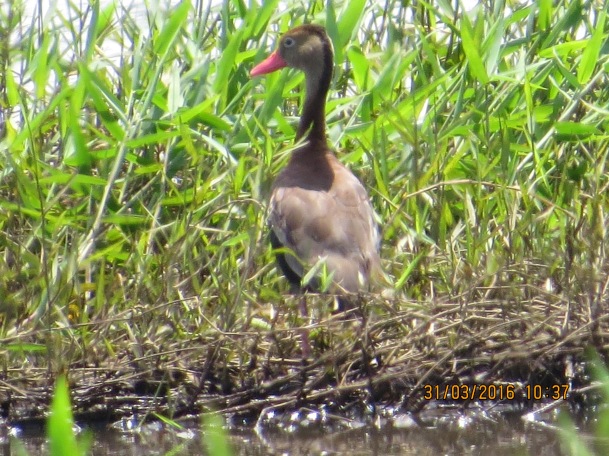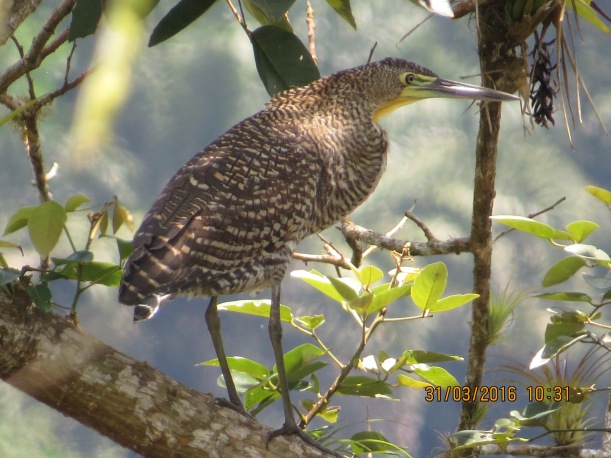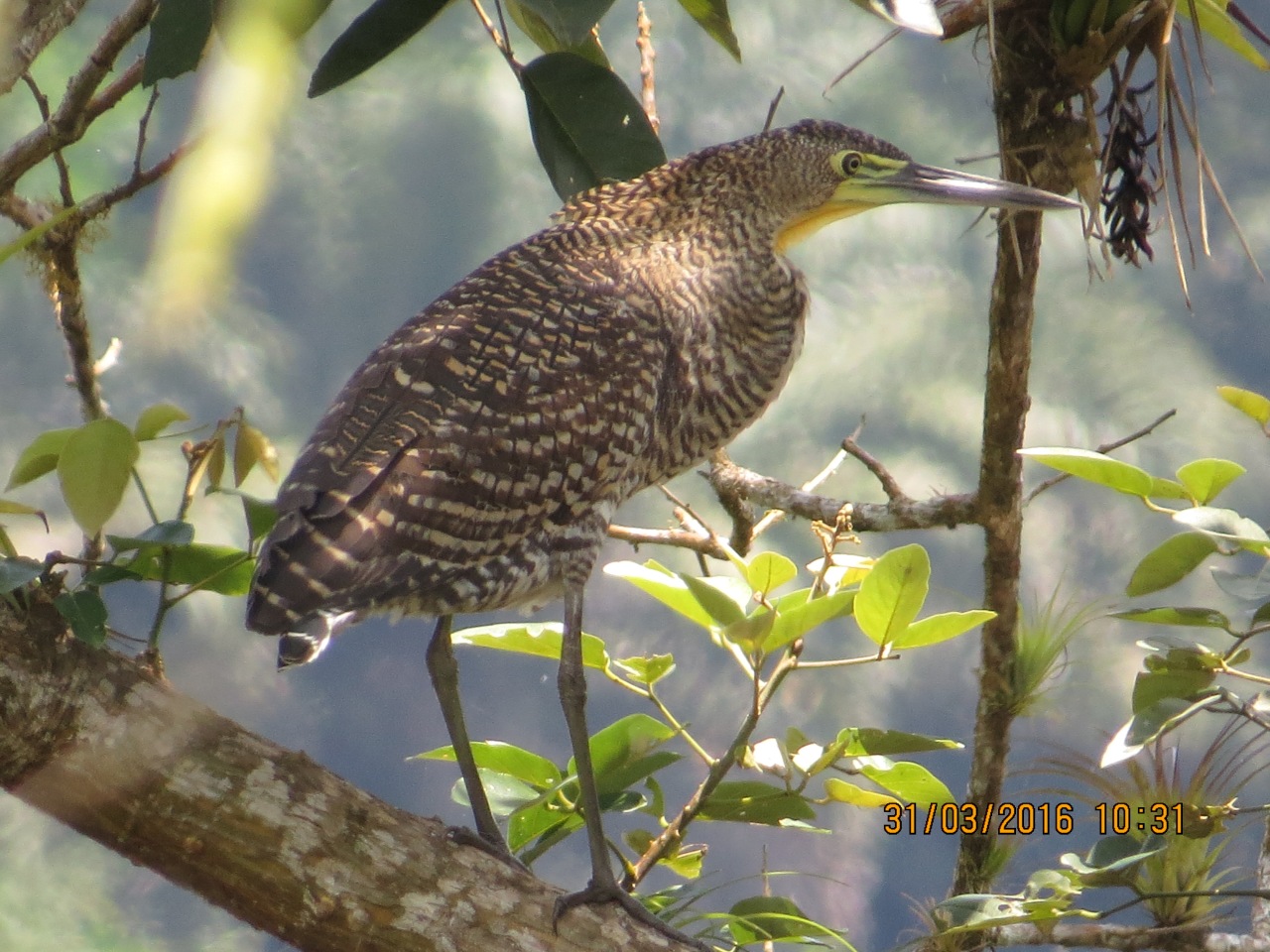John and Milena Beer of Santa Rosa introduced me to a location just above where the mighty Río Reventazón enters Laguna Angostura. The area is thickly forested, with many tall trees, and gives access to swampy land and to the banks of the river itself. No doubt this locale will be even more interesting during the rainy season, while at the moment we are experiencing an unusually dry period.
John y Milena Beer de Santa Rosa me llevaron a un lugar un poco más arriba del punto donde el caudaloso Río Reventazón entra en la Laguna Angostura. Es un área de bosque espeso, con muchos árboles altos, y da acceso a unas tierras pantanosas y a las orillas mismas del río. Sin duda es un sitio que será de aun más interés durante la temporada de lluvias, mientras que por el momento estamos experimentando un verano inusitadamente seco.

Angostura Dam / Laguna Angostura
Nonetheless, quite a few species associated with watery environments were present, plus a few other surprises, best of which was a Gray-headed Kite (Leptodon cayanensis), only my second reported sighting, and my first in our area.
Estuvieron presentes, no obstante, bastantes especies asociadas con el ambiente acuático, además de otras sorpresitas, la mayor de las cuales un Gavilán Cabecigris (Leptodon cayanensis), siendo ésta solamente la segunda vez que reporto esta especie, y la primera en nuestra zona.

Gray-headed Kite near El Copal / Gavilán Cabecigris cerca de El Copal
The photograph above, by kind courtesy of Andrey Acosta, is from a previous excursion to nearby El Copal and Tapantí. Although John managed to obtain photos of many of the birds on today´s trip, the Gray-headed Kite could only be seen with its back to us and it flew before John arrived with the camera.
La foto arriba, por cortesía de Andrey Acosta, es de una visita anterior al cercano El Copal y Tapantí. Aunque John consiguió fotos de muchas de las aves de esta excursión, el Gavilán Cabecigris solo se nos presentó de espaldas y voló antes de llegar John con la cámera.
For a full listing of the day’s sightings, see http://ebird.org/ebird/camerica/view/checklist?subID=S28664065 and the other checklists. These do not include a Northern Bentbill that John and Melina found the next day.
Para tener un listado completo de lo que encontramos aquel día, consulten http://ebird.org/ebird/camerica/view/checklist?subID=S28664065 y listas asociadas. Esto no incluye un Piquitorcido Norteño que John y Melina descubrieron allí al día siguiente.

Black-bellied Whistling-Duck, one of a trio / Pijeje Común, uno de tres
The Black-bellied Whistling-Duck (Dendrocygna autumnalis) is by no means common in our area and this is the first time I have observed it here near Turrialba.
El Pijije (Dendrocygna autumnalis) no es tan común en estas partes y es la primera vez que lo veo cerca de Turrialba.
The Whistling-Ducks were in a swampy area that also harboured this juvenile Bare-throated Tiger-Heron (Tigrisoma mexicanum). Here, this species is at the top end of its elevation range and is the first that I have noted in our area. John was able to take several fine photos. In our area, we normally see only the Fasciated Tiger-Heron on the rocky mountain streams.
Los Pijijes se encontraban en un lugar pantanoso que albergaba también este juvenil de Garza-Tigre Cuellinuda (Tigrisoma mexicanum). Aquí, esta especie está en el límite superior de su distribución altitudinal y éste es el primer individuo que he observado en nuestra zona. John pudo tomar varias muy buenas fotos. En nuestra área solemos encontrar sólo la Garza-Tigre de Río, en las quebradas rocosas de montaña.

A rather shy juvenile Bare-throated Tiger-heron. / Un juvenil de Garza-Tigre Cuellinuda, algo desconfiado.
The pàth here gives good views over the lake, where Lesser Scaup (Aythya affinis) and Least Grebe (Tachybaptus dominicus) were the most visible species. A Wood Stork and a Limpkin were fly-bys.
El camino aquí ofrece buenas vistas de la laguna, donde Porrón Menor (Aythya affinis) y Zambullidor Enano (Tachybaptus dominicus) eran las especies más visibles. En vuelo se vieron un Cigueñón y un Carao.

Full throttle for a Least Grebe, one of 4. / A todo gas, un Zambullidor Enano de entre por lo menos 4.
Finally, here’s a view of the Reventazón downstream, showing a rocky outcrop that Neotropic Cormorant, Blue-winged Teal and various herons and egrets found interesting. Nearby, a pair of Ringed Kingfishers was nesting in a hole in the bank, as were several pairs of Northern Rough-winged Swallows. A Yellow-headed Caracara also sat on a nearby sand-bar.
Finalmente, aquí se ve el Reventazón, fluyendo aguas abajo, con un afloramiento rocoso de gran interés para los Cormoranes Neotropicales y varias especies de garcetas. A poca distancia una pareja de Martín Pescador Collarejo tenía su nido en un agujero en la ribera, mientras hacían igual una pequeña colonia de Golondrinas Alirrasposas Norteñas. Al lado, posado sobre un banco de arena, estaba un Caracara Cabecigualdo.

Río Reventazón on its way to Angostura / El Río Reventazón en su rumbo a Angostura

